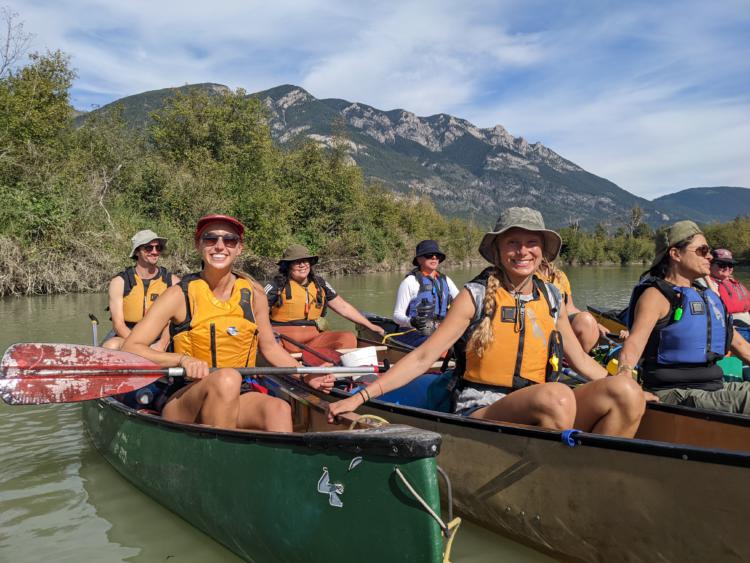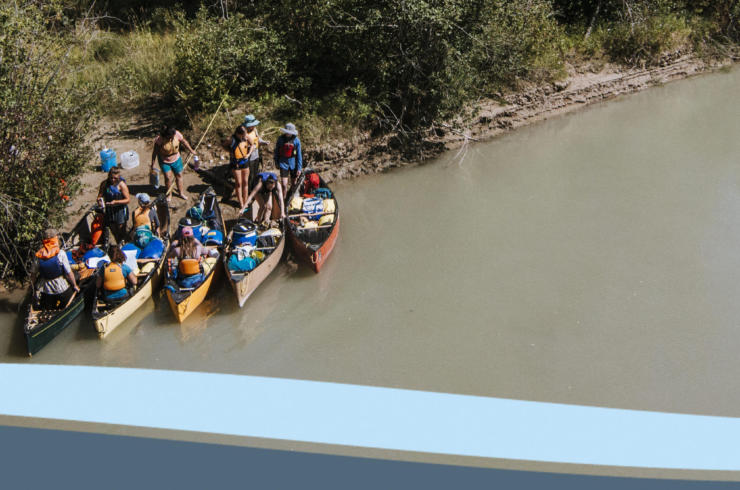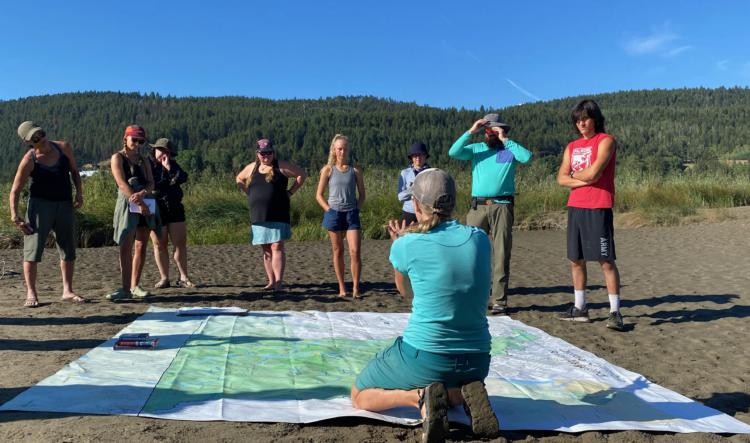It was the last evening of our four-day, three-night adventure. Peaceful calm was in camp as chores were wrapping up, bellies full from dinner. Comfortable chatter from people that started as strangers, but were leaving as friends, could be heard around the rocky campsite along the shores of the Columbia River.
Seventeen sets of eyes were often on the lookout for wildlife, half scanning as we paddled, set up camp, prepared meals, relaxed, and shared learnings and insights.
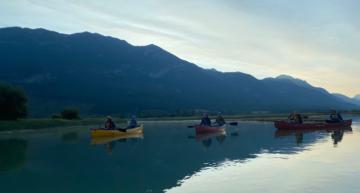
Suddenly a large osprey swooped down in plain sight, deftly scooping a fish up out of the water, a wriggling flash of silver held tight in its talons as it flew off into the evening sky. The moment brought into sharp focus the value of this landscape, not just the beauty it holds, but the life-sustaining, intricate network here that ties the tiniest bug to the largest carnivore. And it captured why we must understand, and protect, this landscape moving forward.
From bird sightings to early morning misty paddles to building up canoe skills and responsible camping practices with Master Instructor Roger Warnatsch, a group of educators were immersed in a Wildsight-led learning opportunity this summer. We brought them out of the classroom, and into nature, to better understand this essential waterway. These environmental educators took to the Columbia River wetlands for four days to learn, share and experience this landscape firsthand. Through it, they found inspiration and knowledge to bring back to their own classrooms.

Ever since the launch of the Columbia River Field School (CRFS), a two-week, immersive summer course for high school students, we’ve dreamed of expanding the reach of this program’s deep learning to more people.
“The young people of the Columbia Basin will inherit this place, and we want them to be empowered to learn about and engage with the watershed,” explains Graeme Lee Rowlands, field school coordinator. “The Columbia River is an amazing river, and it is so rich to engage students with the watershed and all its complexity and beauty.”
Through CRFS, students learn the twists and turns of the Columbia River’s history; how its depths and banks play an essential role in shaping the lives of the communities in this watershed; how it has provided for Indigenous peoples for millennia and how it has been changed by the millions of people that now live around it; how its geography, ecology and hydrology can be studied and interpreted. Through this unique, immersive learning, youth are empowered to help shape the future of the Columbia Basin.
In 2021, we developed our Teach the Columbia (TTC) curriculum to bring the CRFS learning into the classroom through a series of 11 adaptable lessons in four themed modules.
The field course was an opportunity to workshop this curriculum with educators as well as gather valuable feedback to continue improving our lessons. We welcomed 14 participants, ranging from primary to secondary school teachers, learning support staff, outdoor educators, and Indigenous educators, from across the Columbia Basin for this inaugural event.
In introductory remarks to participants, Wildsight Education Director Monica Nissen reflected: “The land is a great place to enter into multidisciplinary, cross-curricular learning. And a watershed is a really wonderful way to just look at things. It’s a nonpolitical, nature-created concept, and it connects us all. Whatever school district we’re coming from and wherever we’re coming from, we’re connected by this river.”
Workshopping curriculum
During the field course, participants worked through several TTC lessons. Gathered around a giant floor map of the Columbia Basin, teachers investigated the physical and human geography of the basin while on the sandy shores of a slough off the main stem of the river. Tall sweeping green grasses spanned the plains around us. Each spring, these low lying areas flood during the freshet and stay wet until waters recede in late summer or fall. Step too far and your feet would find an abundant marsh hidden underneath.
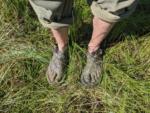
Another lesson walked us through the natural and human-made rise and fall of the river in various locations while the longest un-dammed portion of the Columbia River rippled past us. With more than 60 large dams in the Columbia River watershed, this lesson helps students to understand not just seasonal water fluctuations, but how humans bend nature to our will.
We explored how attitudes about wetlands and rivers and human’s desire to control the water have changed over time; shifting values from seeing the return of salmon to the Upper Columbia as a lost cause to one that, under Indigenous leadership, is gaining momentum and even success.
Deep and meaningful discussions took place as stream water trickled under feet and along rocky paths to the Columbia, each drop passing by eventually making its way to the Pacific Ocean.
This creative bunch explored how to use the Teach the Columbia resource across grades and subject areas, adapting it to fit their needs and creatively expanding it. Even Primary-grade teachers saw ways to utilize the high school-based curriculum, such as taking the concepts of ‘float and sink’ these young learners explore as they engage with their primary-level science curriculum, and directing it to a discussion about dams.

Takeaways
Participants share that they found the field course inspiring as they prepared to head back to classrooms this fall; many envisioning how to integrate the TTC curriculum into their lesson plans.
“The knowledge we gained about the Columbia Basin was extensive; we had amazing networking opportunities to discuss different lessons done by other teachers in their classrooms,” shares Rebecca Lewis, educator at ʔaq̓amnik̓ Elementary School. “This is hands down the best Pro D I have experienced.”
Nelson high school teacher David Bell was interested in the field course after experiencing an environmental education program with Wildsight’s Monica Nissen last year.
“I’ve always had a real passion for outdoor education and place-based learning,” David says.
The field course was a great starting point for learning opportunities for his students this school year, he anticipated.
“The lessons we’ve covered here in the curriculum are super specific. But they can be expanded into even month-long parts of the curriculum. We can start talking about story, and about place, and making connections with students from there.”
South Slocan middle school teacher Carly Christy joined the field course to help increase her own knowledge of the region.
“Learning about the Columbia while on the Columbia provided such powerful context…It moved us to care even more because we were experiencing what we were learning. The pro-D also provided such rich interdisciplinary learning and connected me with other like-minded educators,” says Carly. “Being immersed in this place, with this experience, has given me a more comprehensive experience.”
For Cranbrook middle school teacher Orrin Hawke, the curriculum will help ground his students in where we live.
“It will help students feel connected to place,” says Orrin. “They’ll hear the story and become part of the story, and recognize their place within it.”
We’re grateful for all the educators that chose to join this summer learning opportunity. With the success of this field course, we anticipate hosting more over years to come. To stay informed on future learning opportunities, sign up for TTC updates.
This curriculum package, and field course opportunity, was made possible thanks to the generous support of the Arjay R. and Frances F. Miller Foundation, the Columbia Basin Trust, the Province of B.C., and the Real Estate Foundation of BC.

